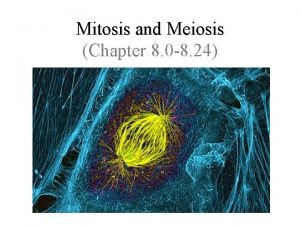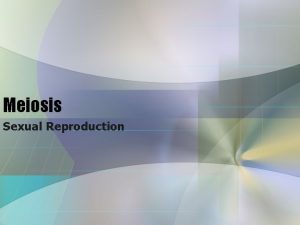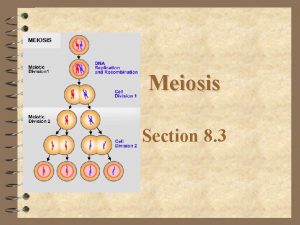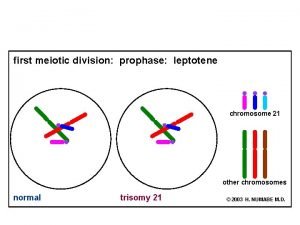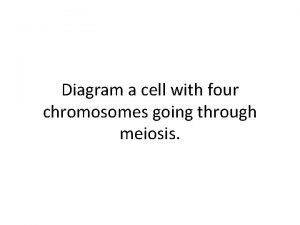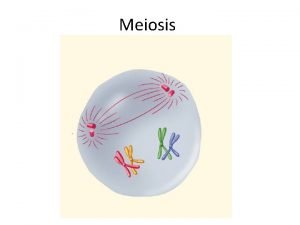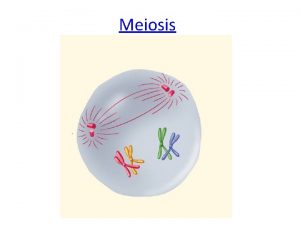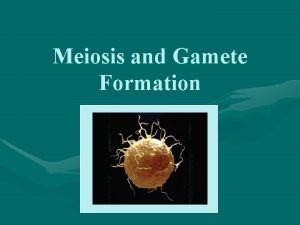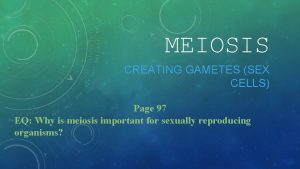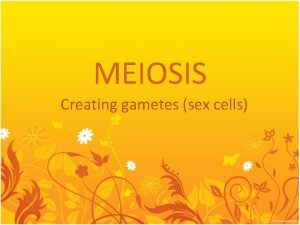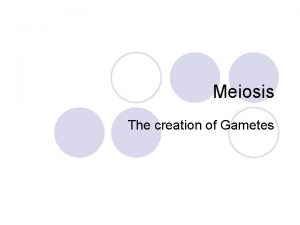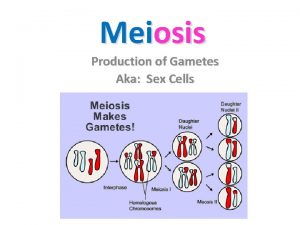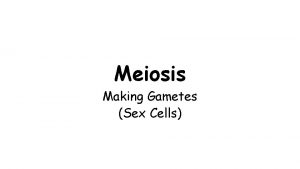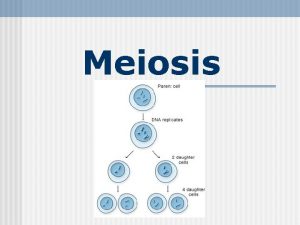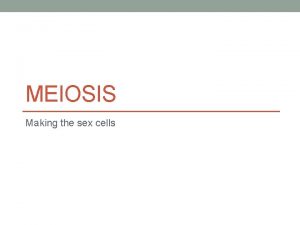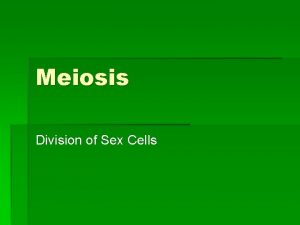MEIOSIS The process of creating gametes sex cells















- Slides: 15

MEIOSIS The process of creating gametes (sex cells)

Meiosis – A Source of Diversity Why do you share some but not all traits of each parent? What are the rules of this sharing? The answers are meiosis.

Chromosome Number • A human body cell has 46 chromosomes • 23 from dad and 23 from mom • These sets of chromosomes are homologous, meaning that each chromosome that came from dad has a corresponding chromosome from mom.

Diploid and Haploid • A cell that contains both sets of homologous chromosomes is said to be diploid. • Diploid= “ two sets”, 2 N, or 2 N=46 • A cell that only contains 1 set of chromosomes is said to be haploid. • Haploid= “one set”, N, or N=23

Phases of Meiosis • Occurs in 2 divisions- meiosis I and meiosis II • In the end one diploid cell will become 4 haploid cells

Chromsomes replicate Meiosis I Crossing over occurs between homologous chromosomes Cell divides Meiosis II Cell divides again

Meiosis • How many times does the cell divide ?

How many cells are formed?

Crossing Over occurs in Meiosis I 1. Homologous chromosomes form a tetrad 2. Chromatids cross over one another 3. The crossed sections of chromatids are exchanged 4. This produces a new combination of genes which contributes to diversity within a population.

Crossing Over-happens in Prophase I: Tetrad formation/ crossing over Because of crossing over, each gamete receives a unique set of genetic information. Telophase II Metaphase I Anaphase I Telophase I

Gametogenesis occurs in Meiosis II • Meiosis II results in 4 haploid gametes (sex cells) • The haploid gamete in males is sperm • The haploid gamete in females is the egg

Mitosis • Results in 2 identical diploid cells • Produces diploid cells • Involves asexual reproduction • 1 division vs. Meiosis • Results in 4 genetically different haploid cells • Produces haploid cells • Involves sexual reproduction • 2 divisions http: //www. pbs. org/wgbh/nova/baby/divide. html

Parent cell and daughter cells are identical Parent cell and daughter cells are genetically different

In meiosis 1 diploid cell becomes 4 haploid cells In mitosis 1 diploid cell becomes 2 diploid cells

Mitosis or Meiosis? • • Asexual Reproduction Mitosis Produces somatic cells Mitosis Produces gametes Meiosis Sexual Reproduction Meiosis Involves crossing over Meiosis Parent cell is identical to daughter cells. Mitosis Parent cell is genetically different than daughter cells Meiosis
 Kurt bumby
Kurt bumby Sex snv
Sex snv Sex sex sex
Sex sex sex Sex sex sex
Sex sex sex Sex sex sex
Sex sex sex What does an individual chromosome look like
What does an individual chromosome look like Meiosis
Meiosis Meiosis reproduction
Meiosis reproduction Meiosis makes gametes
Meiosis makes gametes Four chromosomes going through meiosis
Four chromosomes going through meiosis Haploid vs diploid venn diagram
Haploid vs diploid venn diagram Process of gametes
Process of gametes Organisms have different numbers of chromosomes
Organisms have different numbers of chromosomes Punnett square for sex linked traits
Punnett square for sex linked traits Advanced higher biology unit 2
Advanced higher biology unit 2 Sex determination and sex linkage
Sex determination and sex linkage





